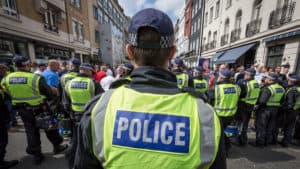
Police officers in a crowded London street
Credit: GUY CORBISHLEY/ALAMY
In the late 1990s, Los Angeles Police Department detectives in California uncovered one of the biggest policing scandals in modern U.S. history. More than 70 officers in the antigang unit of the city’s Rampart Division were accused of stealing drugs, robbing banks, beating suspects, framing defendants, and—in a separate civil suit—conspiring to murder rapper Christopher Wallace, aka The Notorious B.I.G. Researchers have long studied patterns of misconduct in such “rogue units,” to see whether they can identify how misbehavior spreads from one officer to another. Now, a team of economists says it has gone even further and measured, for the first time, the influence that misbehaving officers have on one other.
The approach is “promising,” says Robert Worden, a political scientist who studies criminal justice at the State University of New York in Albany, who was not involved with the work. But he’s skeptical that it reveals anything about how police misconduct really spreads. “It’s really hard to pull together that kind of data,” he says. “There’s no magic bullet.”











Sorry, but the lead in commentary is not only wrong, but an example of what we scream about when Trump lies or exaggerates. Shootings by LEOs are NOT MURDER